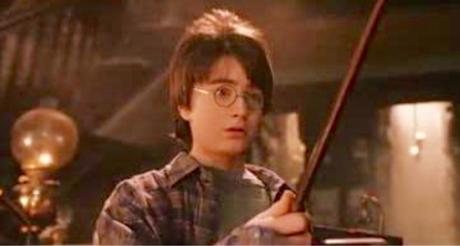
Harry Potter (Daniel Radcliffe) tries out a wand at Ollivander's.
Image from Harry Potter and the Sorceror's Stone copyright 2001 Warner Brothers Entertainment.
This concert performance of the complete John Williams score of Harry Potter and the Sorceror's Stone (that’s the first film, for you Muggles reading this) featured the muscular New Jersey Symphony Orchestra under the baton of guest conductor Justin Freer. Using a digital synchronization screen that showed him exactly where to fit the down beats, Mr. Freer led the film score as the movie played overhead. Playing a film score is not a novel idea for orchestras, but the first Of Willams' three Harry Potter scores is rich in musical interest, even without the accompanying images and dialog.
The composer begins this score with a lilting theme on the celesta, accompanied by a shivering whoosh of atonal strings, sounding like a cold wind arriving from another place. This celesta theme, known as "Hedwig’s Theme”) yields to a rising, Wagnerian melody, the arpeggiation of a minor chord that uses a long-short-long-short rhythm to climb from the murk. Harry himself is revelaled as an infant, rescued from the site of the murder of his parents by Hagrid and broug to live among non-magical (”Muggle”) relatives in an anonymous Surrey suburb.
These themes and other simple ideas are introduced in rapid succession, with the whole opening scene serving as a kernel for the flourishing if musical ideas. The Hedwig theme is tossed from winds to strings to horns, emerging as a triumphant fanfare as the titles come up. A new set of themes introduces the idea of magic, as you g Harry is bombarded with a blizzard of letters from Hogwarts, with wizarding school, and finally meets the gigantic Hagrid, sent to reteieve him when the letters go unanswered.
At this point the reveal of Diagon Alley a wizard shopping street in London yields a stack of new ideas, as Harry and Hagrid acquire his school-things and the young wizard-to-be sets out northward on the Higwarts Express. At this point his chums Ron and Hermione are introduced, each with their own leitmotif and cheers from their fans in the audience, some of them robed, wigged and wearing one of the four House scarves. (Your humble reviewer is a proud Slytherin.)
Hogwarts itself, the Great Hall and the Sorting Hat appear in a fanfare of brass and major-key strings, it is at. this point in the film, one regrets the subtraction of the Sorting Hat song and the Hogwarts school song, (”Everyone pick your favorite tune!”) moments of musical comic relief in the original novel. (Those ideas are in the longer cut of the fourth movie, with music by Patrick Doyle.) Their absence was made up for by the cheers from members of the audience as the four Hogwarts Houses were introduced.
The first intermission was taken just after Harry, Ron and Hermione sealed their friendship by knocking out an errant mountain troll. This allowed the introductoon of menacing minor-key chords and heavy brass, which would dominate the second half of the score. Menacing sequences in the Forbidden Forest and the climax deep in the Hogwarts dungeons showed Williams’ virtuoso abilities as an orchestrator, incorporating twelve-tone rows and bitonal chords in a way that would give horror and shock to the average concert-goer weaned on Beethoven. For the assembled, who stayed rapt as Mr. Freer conducted over the lomg closing credits, these modern musical techniques provoked only delight,

